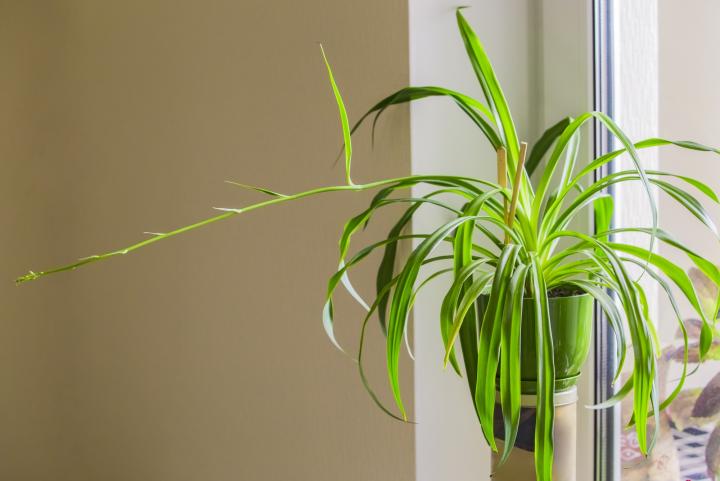
Spider plants, scientifically known as Chlorophytum comosum, are popular houseplants appreciated for their graceful foliage and ease of care. One intriguing aspect of spider plants is their ability to produce small offshoots known as “plantlets” or “babies.” In this article, we’ll delve into the fascinating relationship between spider plant flowers and the production of these babies.
**I. Introduction**
**A. Overview of Spider Plants**
Spider plants are prized for their arching leaves adorned with white stripes, making them a favorite choice for indoor and outdoor settings alike. They are renowned for their air-purifying qualities and adaptability to various growing conditions.
**B. Role of Flowers in Spider Plant Reproduction**
While spider plants primarily reproduce through vegetative propagation, their flowers play a crucial role in the reproductive process by producing seeds that can lead to the formation of new plants.
**C. Question of Spider Plant Flowers Producing Babies**
Many plant enthusiasts wonder whether spider plant flowers directly transform into the iconic plantlets, sparking curiosity about the connection between flowers and baby production.
**II. Understanding Spider Plant Flowering**
**A. Conditions for Flowering**
**1. Adequate Light**
Spider plants require bright, indirect light to initiate flowering. Placing them near a window where they receive sufficient sunlight promotes flower formation.
**2. Proper Watering**
Consistent watering is essential for spider plants, as both underwatering and overwatering can inhibit flower production. Maintaining moderate soil moisture levels is key to encouraging blooms.
**3. Ideal Temperature**
Spider plants thrive in temperatures between 65°F to 75°F (18°C to 24°C) and may exhibit flowering behavior when provided with optimal environmental conditions.
**B. Appearance of Spider Plant Flowers**
**1. Characteristics**
Spider plant flowers are small, white, and star-shaped, emerging from long stalks known as peduncles. Each flower cluster contains multiple individual blooms.
**2. Timeframe**
Flowering typically occurs during the plant’s active growing season, which spans spring and summer months. However, individual plants may vary in their flowering patterns.
**C. Pollination Process**
**1. Self-Pollination**
Spider plants are capable of self-pollination, where pollen from the male reproductive organs (anthers) is transferred to the female reproductive organs (stigma) within the same flower.
**2. Cross-Pollination**
In outdoor settings, spider plant flowers may undergo cross-pollination facilitated by insects such as bees, leading to genetic diversity and potential seed production.
**III. Spider Plant Baby Production**
**A. Formation of Plantlets**
**1. Location**
Spider plant babies, or plantlets, develop at the ends of long, wiry stems called stolons that originate from the mother plant.
**2. Growth Process**
As the plantlets mature, they develop roots and eventually detach from the parent plant, ready to establish themselves as independent entities.
**B. Role of Flowers in Baby Production**
**1. Relationship between Flowers and Plantlets**
While spider plant flowers do not directly transform into babies, they produce seeds that, under favorable conditions, can germinate and give rise to new plantlets.
**2. Seed Formation**
After successful pollination, spider plant flowers may develop seed pods containing viable seeds. These seeds can potentially germinate and grow into new spider plants if provided with suitable growing conditions.
**C. Factors Affecting Baby Production**
**1. Environmental Conditions**
Optimal light, temperature, and humidity levels contribute to healthy flower and seed development, ultimately affecting the production of spider plant babies.
**2. Genetics**
Genetic factors play a role in determining the likelihood of flower and baby production in spider plants. Some cultivars may exhibit prolific flowering and baby production, while others may be less inclined to do so.
**IV. Caring for Spider Plant Babies**
**A. Separating Plantlets**
**1. Timing**
Wait until spider plant babies have developed sufficient roots before separating them from the parent plant, typically when they are a few inches long.
**2. Method**
Gently remove the plantlets from the stolons and pot them in well-draining soil, keeping them adequately watered until they establish themselves.
**B. Potting Spider Plant Babies**
**1. Soil Requirements**
Use a well-draining potting mix formulated for houseplants to provide adequate aeration and moisture retention for spider plant babies.
**2. Container Selection**
Choose small pots or containers with drainage holes to prevent waterlogging and promote healthy root growth in potted spider plant babies.
**C. Maintenance Tips**
**1. Watering Needs**
Water spider plant babies when the top inch of soil feels dry to the touch, ensuring thorough but not excessive moisture to prevent root rot.
**2. Light Requirements**
Place spider plant babies in bright, indirect light to encourage healthy growth and development, avoiding direct sunlight to prevent leaf scorching.
**V. Conclusion**
**A. Recap of Spider Plant Reproduction**
Spider plants exhibit a fascinating reproductive process involving flowers and the production of plantlets or babies, contributing to their popularity as houseplants and ornamental additions to indoor spaces.
**B. Importance of Understanding Flower and Baby Production**
Understanding the role of flowers in spider plant reproduction provides valuable insights for plant enthusiasts seeking to propagate and care for these beloved botanical specimens.
**C. Encouragement for Spider Plant Enthusiasts**
Whether you’re a seasoned gardener or a novice plant parent, exploring the world of spider plant propagation can be a rewarding journey filled with learning opportunities and botanical wonders. Embrace the magic of spider plant flowers and babies as you nurture these resilient and beautiful plants in your home or garden.


